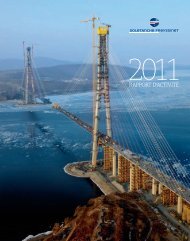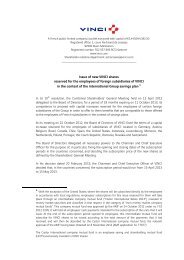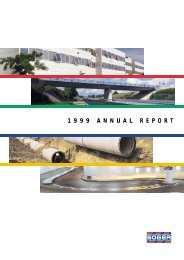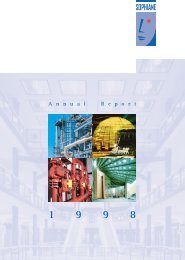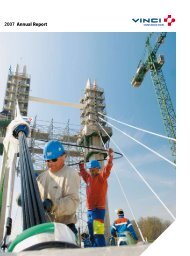VINCI - 2005 annual report
VINCI - 2005 annual report
VINCI - 2005 annual report
Create successful ePaper yourself
Turn your PDF publications into a flip-book with our unique Google optimized e-Paper software.
– when borrowing is not intended to finance a specific project, the interest<br />
eligible for capitalisation on an asset is determined by applying a<br />
capitalisation rate to the expenditure on that asset. This capitalisation rate<br />
is equal to the weighted average of the costs of borrowing funds other<br />
than those specifically intended for the construction of given assets.<br />
Income tax<br />
Income tax is computed in accordance with the tax legislation in force in<br />
the countries where the income is taxable.<br />
In accordance with IAS 12, deferred tax is recognised on the differences<br />
between the carrying amount and the tax base of assets and liabilities,<br />
using the latest tax rates known. The effects of a change in the tax rate from<br />
one period to another are recognised in the income statement in the period<br />
in which the change occurs.<br />
Deferred tax relating to items recognised directly under equity is also<br />
recognised under equity.<br />
A deferred tax liability is recognised in respect of the differences relating<br />
to shareholdings in equity-accounted or proportionately consolidated<br />
entities, unless:<br />
– the group can control the date at which the temporary difference will<br />
reverse; and<br />
– the difference is not expected to reverse in the foreseeable future.<br />
Net deferred tax is determined on the basis of the tax position of each<br />
entity or group of entities included in the tax group under consideration<br />
and is shown under assets or liabilities for its net amount per taxable<br />
entity.<br />
Deferred tax is reviewed at each balance sheet date to take account in<br />
particular of the impact of changes in tax law and the prospects for recovery.<br />
Deferred tax assets are only recognised if their recovery is probable.<br />
Deferred tax assets and liabilities are not discounted.<br />
Earnings per share<br />
Earnings per share (non-diluted) is the net profit for the period after<br />
minority interests, divided by the weighted average number of shares<br />
outstanding during the period less treasury shares.<br />
In calculating diluted earnings per share, the average number of shares<br />
outstanding is adjusted for the dilutive effect of equity instruments issued<br />
by the Company, such as convertible bonds and share subscription or<br />
purchase options.<br />
Intangible assets<br />
Intangible assets mainly comprise operating rights, quarrying rights of<br />
finite duration and computer software. Purchased intangible fixed assets<br />
are recorded in the balance sheet at acquisition cost and are amortised on<br />
a straight-line basis over their useful life.<br />
CONSOLIDATED FINANCIAL STATEMENTS<br />
Goodwill<br />
Goodwill is the excess of the cost of a business combination over the<br />
Group’s interest in the net fair value of the identifiable assets, liabilities and<br />
any contingent liabilities at the date(s) of acquisition, recognised on first<br />
consolidation.<br />
Goodwill relating to controlled entities is shown under the balance sheet<br />
assets under goodwill. Goodwill relating to entities accounted for using<br />
the equity method is <strong>report</strong>ed under investments in associates.<br />
Goodwill is not amortised but is tested for impairment at least <strong>annual</strong>ly<br />
and whenever there is an indication that it may be impaired. Whenever<br />
an asset is impaired, the difference between its carrying amount and its<br />
recoverable amount is recognised as an operating expense in the period<br />
and is not reversible.<br />
Negative goodwill is recognised directly in profit or loss in the year of<br />
acquisition.<br />
Concession intangible fixed assets<br />
The costs of concession contracts are shown on a specific line in the balance<br />
sheet as concession intangible fixed assets. They are amortised on a straightline<br />
basis over the period of the contract, starting at the date of entry into<br />
service of the assets.<br />
Renewable assets are depreciated on a straight-line basis over their useful<br />
life. Supplementary depreciation charges are made in respect of renewable<br />
assets that are returned for no consideration to the concession grantor, in<br />
order to bring their residual value to zero at the end of the contract.<br />
Grants related to assets<br />
Grants related to assets are presented in the balance sheet as a reduction<br />
of the amount of the asset for which they were received.<br />
Property, plant and equipment<br />
Items of property, plant and equipment are recorded at their acquisition<br />
or production cost less cumulative depreciation and any impairment losses<br />
recognised. They are not revalued.<br />
Depreciation is generally calculated on a straight-line basis over the period<br />
of use of the asset. Accelerated depreciation may however be used when<br />
it appears more appropriate to the conditions under which the asset is<br />
used. For certain complex assets comprising various components, in<br />
particular buildings and constructions, each component of the asset is<br />
depreciated over its own period of use.<br />
The main periods of use of the various categories of items of property,<br />
plant and equipment are as follows:<br />
Constructions<br />
– structure between 20 and 40 years<br />
– general technical installations between 5 and 20 years<br />
Site equipment and technical installations between 3 and 12 years<br />
Vehicles between 3 and 5 years<br />
Fixtures and fittings between 8 and 10 years<br />
Office furniture and equipment between 3 and 10 years<br />
Depreciation commences as from the asset’s entry into service.<br />
201






